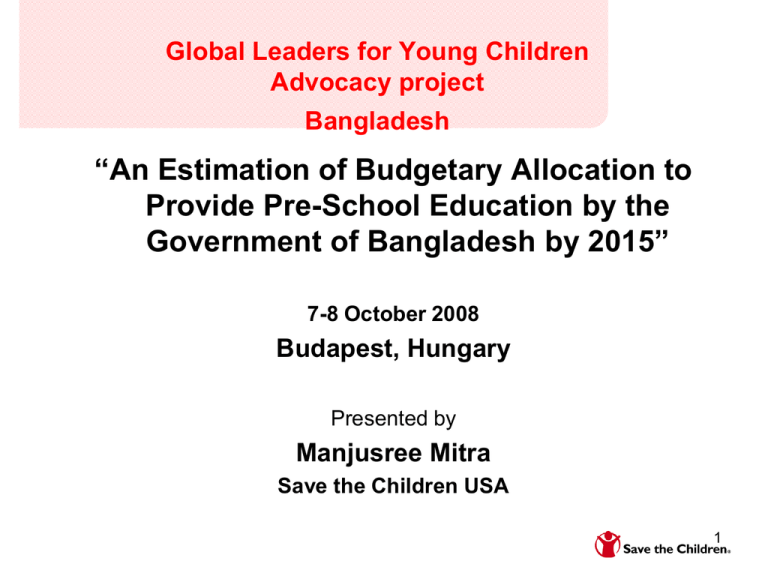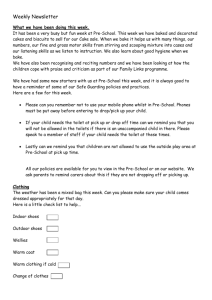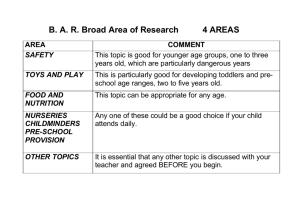An Estimation of Budgetary Allocation to Provide Pre
advertisement

Global Leaders for Young Children Advocacy project Bangladesh “An Estimation of Budgetary Allocation to Provide Pre-School Education by the Government of Bangladesh by 2015” 7-8 October 2008 Budapest, Hungary Presented by Manjusree Mitra Save the Children USA 1 Goal: Increase investment in Early Childhood Development in Bangladesh Specific Objectives: • Explore the ECD services by government and NGOs. • Calculate the pre-school related expense in National Budget and draw the trend. • Summing up the existing pre-school programs by public and private sector. • Estimate the amount of budget necessary to attain the preprimary target as specified in ‘Operational framework for Pre-primary education’. 2 Steps of Implementation: • The project proposal was shared and consulted with the senior officials and feedback were received to finalize the project. • A consultant was hired to assist in collecting data and analyzing them. • Both qualitative and quantitative methods were applied to collect data from GOs/NGOs/private sector and interpret them. Semi-structured Interview and informal discussion were resorted to know about the pre-school activities of different organizations and collect relevant data. 3 Steps of Implementation Continued…. • Interviews were conducted with the ECD Experts, Implementers, secretary of Ministry of Women and Children’s Affairs (MOWCA) and Ministry of Primary and Mass Education (MOPME). • Appropriate tools like discussion guidelines and checklists were developed to collect information. • ECD Programs of Government, INGOs and National NGOs were visited. • Shared the findings in the organizations. 4 Findings: Government of Bangladesh: Baby Class- A Preschool Activities in primary school Informal Baby classes are taking place in total 26,299 schools where in total 1,101,395 children No updated primer since 1997 3 to 5 years old Children attend in baby class Teachers shows lack of interest because of GoB is still giving less priority 5 Government project funded by Unicef (2001-10) Activities : • 1 year play group for 4-5 year old children • 1 year pre-school for 5-6 year old children Implementing Agencies: • BSA, City Corporations, BRAC, Grameen Shikkha • Centres and Coverage: • 404 Play Group and 1,380 Pre-schools 6 Pre-School at Chittagong Hill Tracts funded by Unicef Duration: 1996-2010 Activities: 2 year play group for 3-5 year old children, and 1 year pre-school course for 5-6 year old children Teaching Method: Multilingual Teaching Learning Centres and Coverage: 2,278 Play Group and Pre-schools Per-child cost: establishment - BDT 1,818 (US$ 26) running - BDT 744 (US$ 10.6) 7 Preschool Activities by Private Sector Non -Profit Actors Profit Actors Non Profit Actors Leading actors: BRAC, Save the Children USA (SC USA), Plan Bangladesh, DAM, Grameen Shikkha Coverage: 147 organizations (16 organizations cover 95%) - 64 districts - 791,500 children in 2006. ***Many projects are Donor Driven 8 Non -Profit Actors Plan Bangladesh & BRAC ECD Activities Plan : Parenting Education- 444 parent groups Play group-1761 1 year pre-school for 5-6 year old children - 509 pre-school Day Care at Slum -21 Day care Next Plan: Operate pre-schools by Local Government BRAC: 1 year pre-school for 5-6 year old children No. of Centre: 25,000 Extra feature: Tutorial Support at primary level Next Plan: Adding… 2600 (GOB Agreement) by 2009, 5000 by 2010 9 Non -Profit Actors Save the Children USA ECD activities Core program: 2 years Pre school package - Ankur & Kisholoy (4 years and 5 years old children) Reading for Children Parental education Cultural program Graduation ceremony Transition to primary school & follow up SUCCEED Project (2004-09) Parenting Education 1 year pre-school for 5-6 year old children No. of Centre: 1800 pre-school every year 10 Operational Framework Long term vision is that children, 3-5 years of age, are attending pre-school programs of some kind and have access to programs of health, nutrition, social, physical and intellectual development, and being initiated into formal education. Short term vision is to include all children of 5 to below 6 age group under pre-school education. Target Population: • children of poor families, • children from disadvantaged communities, • children of ethnic minorities, • children with various disabilities, and • children living in geographically remote are 11 Findings: Per Child Cost Comparison… Type of Pre school 1 year model 2 years model Name of the organizations & per child cost per year BRAC Plan Bangladesh US$ 33 (2009) 1stst year US$ 32(2008) 2nd Year US$ 21 Save the children USA Governme nt US$ 61.5 (SUCCEED) Baby classUS$ 6 1st year US$ 20 2nd year US$ 15 Rural US$ 45 Slum US$ 58 UNICEF Rural US$ 45 Slum US$ 58 12 Profit Actors: Per Child per year Cost Comparison… Kindergartens English-medium Schools Cost: US$ (42.8- 50) US$ (657.1-714.3) to to US$ (257US$ (1285.7-1714.3) 285) per per annum annum Remarks Teacher salary, materials , students fees 13 Budgetary Allocation in Primary Education • GOB’s educational spending as proportional of GNI was 2.3% in 1999-00 and remained similar in 2006-07. • As GNI increased over the period, public education spending increased by 50% in real terms from 1999-00 to 2006-07 (BDT in Million) Fig 7.1: Budgetary Allocation in Primary Education 45000 40000 35000 30000 25000 20000 15000 10000 5000 0 1999-00 2000-01 2001-02 2002-03 2003-04 2004-05 2005-06 Fiscal Year Revenue Development Total -primary 14 Key variables of estimating the budget Who will provide the service? What is the size of target service recipients? What will be the cost of the service? Answer to the Question # 1 According to GoB’s framework: • NGOs will open new pre-school facilities to provide preschool services to new clients. • GoB will continue the existing 26,299 ‘baby classes’ attached with primary schools and undertake necessary improvement of activities to align them with the 1 year preschool plan. Answer to the Question # 2: • 51.8% of the Child Population of 5-6 years age Answer to the Question # 3: • Per child Cost US$ 34 per year 15 Estimation of budget needed to cover operation framework target and the entire child population Year Estimated Budget allocation in Primary Education (M) Additional Budget requirement as per Operational Framework Target (H) Share (N=H /M*10 0) Additional Budget requirement to cover entire child population (L) 2009-10 646.03 9.92 1.5 19.01 2.9 2010-11 671.03 20.49 3.1 39.27 5.8 2011-12 696.99 31.65 4.5 60.68 8.7 2012-13 723.96 43.26 6.0 82.95 11.5 2013-14 751.98 55.15 7.3 105.74 14.1 2014-15 781.07 67.15 8.6 128.78 16.5 2015-16 811.30 75.39 9.3 144.59 17.8 Share (N=H/ L*100) 16 What is Missing in Operation Framework • According to NPA II, early childhood development program should follow an integrated strategy that combines health (health check up), nutrition (nutritional supplements and parental education on child nutrition, school feeding), sanitation (clean water and parental education on sanitation and diarrhoea) and education activities in the centre. • Operational Framework only focused on Pre school education. • … Certainly this stand alone education program will not significantly contribute in the holistic development of the child (as envisaged by the arguments of ECD. ) 17 Need to be give emphasis on … Special attention to Ethnic/language Minorities Feeding and Stipend program for ultra poor and disadvantaged children Observing the school learning environment Ensuring the quality of Teachers Facilitating the transition to primary School Linking with other Child related health services 18 Lesson Learned/ Challenges: • During the project NGOs, INGOs and National NGOs provided information willingly. • The Ministry of Education was also showed their interest and waiting for the finding of the project. • Project goal matched with organizational advocacy strategy and it works effectively. • Appropriate person skilled in budget analysis and having sound knowledge on ECD was not available to recruit. • Operation Framework of pre school was not clearly define the implantation process, so to take forward this is difficult. • Different organizations have different curriculum with different cost. • Advocating within organization was also a challenge. 19 What next • Publish the study report • Conduct Round table discussion in February 2009 • Prepare a Policy brief and share with Education Ministry. Thank You for Listening with Patience. 20






